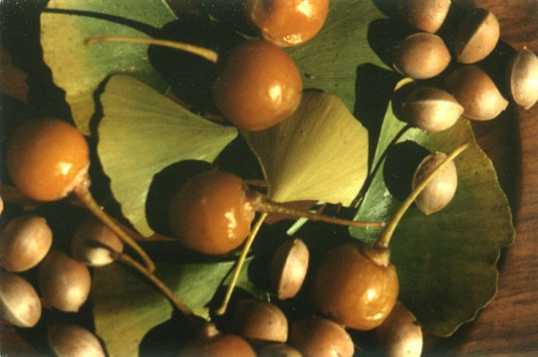
Ginkgo biloba (L)
Synonyms and Common names: Maidenhair tree, Kew tree, Fossil tree
Order: Ginkgoaceae

Description: The dioecious Ginkgo tree can reach a height of 40m in its natural habitat in Central China. It prefers rich sandy soil, and has one or several main trunks and spreading branches. The leaves are petiolate, glabrous and bilobed; each lobe is triangular, up to 6cm long and 4cm wide, with fan-like, fine, prominent radiate veins and an entire margin. The leaves turn yellow in autumn. The female trees produce a fleshy fruit with an edible kernel if there is a male tree nearby. Ginkgo is now grown on large plantations in China, France and South Carolina.
Parts used: leaves, seeds
Collection: The leaves are harvested in summer and autumn; the ripe seeds are collected and dried in autumn. After the shells of the seeds have been broken, the seeds are removed and pounded into pieces.
Constituents: Leaf: amino acids; bioflavonoids (including quercitin, kaempferol) and their glycosides; proanthocyanidins; terpenoids (bilobalide, ginkgolides A,B,C), sito-sterol. Many Ginkgo biloba supplements are standardised to contain 24% flavone glycosides. Seeds: Alkaloids (ginkgotoxin); amino acids; cyanogenetic glycosides; phenols, fatty acids, bioflavones.
Actions: platelet activating factor antagonist, circulatory stimulant and tonic, anti-asthmatic, antispasmodic, antiallergenic, anti-inflammatory.
Indications: cerebral insufficiency, intermittent claudication
Therapeutics and Pharmacology: The ginkgolides present in the leaf help alleviate the adverse effects of platelet-activating factor (PAF) in a number of tissues and organs because they competitively inhibit the binding of PAF to its membrane receptor. Clinical trials have demonstrated that ginkgo preparations are effective in the treatment of arterial insufficiency, particularly in the lower limbs and brain. Patients with intermittent claudication showed significant improvements in pain-free walking time and maximum walking distance. Elderly patients with chronic cerebral insufficiency demonstrated a significant regression of major symptoms including vertigo, tinnitus, headache, short-term memory, vigilance and mood changes. However, heart rate, blood pressure and blood levels of cholesterol and triglycerides were unaffected, and the extract had no effect on normal healthy subjects. Ginkgo has been shown to improve glucose utilisation within the brain. It improves the transmission of nerve impulses and increases alertness by increasing the brain's alpha wave rhythms and decreasing theta rhythms. It has a demonstrable effect on the venous system too and is used to treat conditions such as varicose veins.
Ginkgo alleviates male impotence where the underlying cause is impaired blood circulation to erectile tissue; initial signs of improvement were seen to commence after 8 weeks of Ginkgo biloba supplementation and, after 6 months, 50% of patients had regained potency.
Recent research has shown that the extract GBE from the yellow autumn leaves contains a vitamin that strengthens blood vessels, reduces the production of tissue-damaging free radicals and improves cellular energy. The bioflavonoids protect and maintain the integrity of capillary walls, inhibit lipid peroxidation within cell membranes, stabilise the cell membranes involved in the blood-brain barrier, destroy free radicals and inactivate their formation. Ginkgo has been shown to improve eyesight in senile macular degeneration and to neutralise the effects of oxygen free radicals produced in the eyes.
In European clinical trials, improvements in allergic responses such as asthma have been observed. Ginkgo is thought to alleviate allergies by inhibiting the activity of eosinophils, an action attributed to Ginkgolide B. Its ability to reduce inflammation may make it valuable in the future for conditions such as autoimmune problems, multiple sclerosis and organ transplants. Some anti-tumour activity against sarcoma in mice has been recorded.
Contraindications: No significant side-effects or interactions with existing medication such as cardiac glycosides and antidiabetic drugs have been noted in clinical trials with the leaf extract.
Mild adverse reactions such as gastrointestinal upset and headache have been reported. Contact with or ingestion of the fruit pulp can cause an allergic reaction � the seeds contain the toxin 4-0-methylpyridoxine which is reported to be responsible for �gin-nan� food poisoning in China and Japan.
Preparation and Dosage: (thrice daily)
Not included on GSL
Leaf extract: 80-120mg daily
Solid extract: 40mg thrice daily
Fluid extract: 1:1 0.5ml thrice daily
Additional Comments: Ginkgo is the sole survivor of a primitive order of plants dating from 200 million years ago. One reason for its longevity is its ability to withstand insects, disease and pollution due to the unique mix of pharmacologically active compounds in its leaves. The earliest record of its medicinal use is in �Chen Houng Pen T�sao� published in 2800 BC. The Chinese recommend the leaves as being beneficial to the heart and lungs and use it to treat asthma, chilblains and as an anti-tussive and expectorant. They use the seeds, bai guo, in asthmatic disorders and chesty coughs with a thick phlegm. They also appear to act as a tonic to the bladder and have been used in the treatment of urinary incontinence and frequency.
Ginkgo is currently one of the bestselling herbal medicines in France and Germany where it is taken by middle-aged and elderly people wishing to improve their cerebral circulation and memory.
In Asia, the seeds are used to aid digestion and to reduce the intoxicating effects of alcohol; Japanese bars serve them as an accompaniment to drinks.
Bibliography
Bartram, T. 1995 Encyclopaedia of Herbal Medicine, 1st edn.,Grace Publishers, Bournemouth.
Bremness, L. 1994 Herbs, Dorling Kindersley Eyewitness Handbook, London.
Chevallier, A. 1996 The Encyclopaedia of Medicinal Plants, Dorling Kindersley, London.
Corrigan, D. 1993 Ancient Medicine: Ginkgo biloba, Amberwood Publishing, Christchurch
Hyperhealth 1996 Natural Health and Nutrition Databank, v.96.1 CD-ROM, available from Healthworks, Leeds.
Kleijen, J. & Knipschild, P. 1992 Ginkgo biloba, in The Lancet, Vol.340 pp.1136-1139, 1992.
Newall, C.A., Anderson, L.A., & Phillipson, J.D. 1996 Herbal Medicines: A Guide for Health-care Professionals, The Pharmaceutical Press, London.
Ody, P. 1993 The Herb Society's Complete Medicinal Herbal, Dorling Kindersley, London.
Rogers, S.K. 1995 British and Chinese Herbal Pharmacopoeia, Healthlink Software Systems, Queensland, Australia
Weiss, R.F. 1991 Herbal Medicine, Beaconsfield Arcanum, Beaconsfield.
Wren, R.C. 1988 Potter's New Cyclopaedia of Botanical Drugs and Preparations, C.W.Daniel, Saffron Walden.










